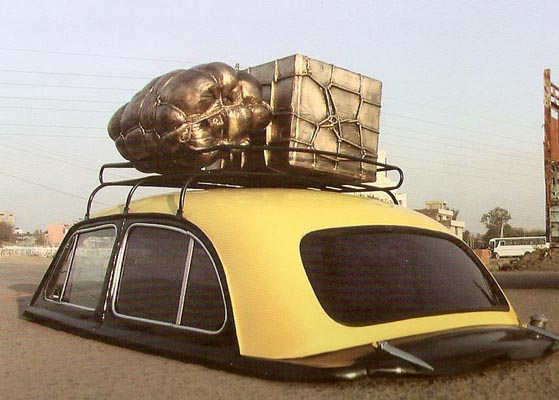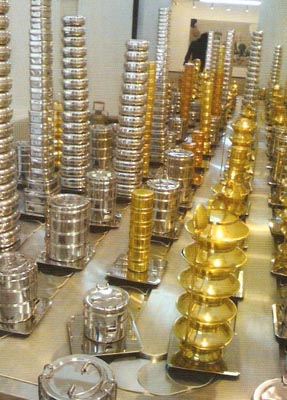![]()
|
||||||||||||||||||||||||||||||||||||||||||||||||||||||||||||||||||||||||||
|
|
||
|
Cultures and many locales Bhavna Kakar takes a look at Subodh Gupta's works which touch the notion of culture, flowing through different locations and timeframes.
Subodh converts banal objects into icons of our ordinary
lives. He is a maker of irreverent icons. The everydayness of objects
is suddenly broken with an artistic intervention and at the same time
the aesthetical intervention is brought down to a kind of banality in
this act. With one stroke Subodh erases the distinction between the
quotidian and the aesthetical and this coalescing with ease and humor
gives a certain amount of ambiguity to the object, which now is
selected and aesthetically mediated (or re-casted through a medium
which is not 'natural' to the casted object).
Subodh Gupta's
works
portray
objects
and
images
of indecisive
moments
and
cultural
fluctuations.
During
the past
decade,
his
art has
employed certain
clichéd
emblems of
India:
the cow,
stainless
steel
kitchen articles,
the scooter,
cow dung cakes,
and his own persona
as
a man
from
a
village
in
Bihar.
All
along,
Gupta's
purpose
was
two-fold -- to both edify such emblems
and
to critique
them.
Since his aim is
dual, to
elevate and reprimand,
his penchant
is usually
for
images
and objects which
already possess
an internal hybridity
which already appear to be comically confused
themselves. In one of his works, The Way Home II of 1999, the artist placed a life-size cow, cast in fiberglass and painted white, within a circular field surrounded by a combination of steel kitchen utensils and ersatz country-made pistols. Here, violence lay camouflaged and dormant within the bosom of domesticity, the symbol of a transcendent purity inaccessible and immobile at the center. My Mother and Me was an architectonic form assembled entirely from cow-dung cakes, a Utopian structure that fused the ancient practices of the rural village with Modernism. In another work, Gupta's self-portrait painting, its background smeared with cow-dung, blinks the word "Bihari" in fairy lights, a tongue-in-cheek parody of the ambitions of the hopelessly downtrodden to actualize their "Bollywood Dreams." Saat Samundar par (Across the Seven Seas) is the title given to a series of large-scale oil paintings that capture a mid-migratory point, the no-man's-land that is the airport today. When viewing Gupta's paintings we are forced to ask ourselves if the journey is at its very beginning or is it reaching its close? Are the subjects coming, going, or hung in the purgatory of delayed departures or early arrivals? An interstitial point both in space and time, the airport signifies exhilaration and anxiety, the tedious boredom that accompanies the most extreme physical dislocation.
Gupta
paints
the
markers
of
this
transgression,
the
precious
cargo
that
accompanies
the
passenger.
As
if
to say that we
are
nothing
more
than
the
merchandise
we
drag
around
with us:
"I
Pack Therefore
I Am."
Poised upon a
wheeled trolley are
suitcases
and
packages
that
represent
a
life
condensed,
the
most
necessary
objects
(both
in terms
of
quotidian task and
emblematic
strengths)
are
swaddled
into
vinyl boxes
or
trussed
into
bulging bundles.
In
an exhibition
in
2003,
Gupta
accompanied
this
series
of
paintings
with
sculptures
of
cast-bronze
airport
trolleys
and
luggage that
had
been cast
in
aluminum,
their
preparations
agile
and
constantly
shifting
much
as
the
impulsive choreography
which
takes
place
at
the
airport
itself.
Chance
and
arbitrary
concurrence
are exploited
(all the
works being based on the artist's
own preliminary
photographs)
so
as
to
create
monuments
of a transient
nature.
Likewise,
a sculpture depicting packages hoisted
upon the
luggage
rack
of a taxi
connotes
not only tourism
and the economy
of its
infrastructure
but also the flight abroad
of
families
and
their
eventual,
perhaps
only
temporary,
return
to
India.
In
this
mix are
complex feelings of insecurity
and
aggravation,
nationalist
pride
and
materialistic
yearnings.
Gupta
cannily
spotlights
the
simple
articles
that
symbolize
a myriad
of
social
and
psychological
conundrums
such
as
these.
His
sculpture
entitled
Colgate
is
the
aluminum casts of simple sticks
of neem, herbal
wood used
for
medicinal
purposes
and
traditionally
in India
for
dental
hygiene.
According to Peter Nagy, by continuing to focus
on emblems of everyday
India,
symbols which straddle the rural and urban scenarios, Gupta flirts
with the sentimentality which still propels much of what registers as
contemporary art in India today.
What is produced, in effect,
is indigenous
Orientalism,
one that portrays
a rural ideal that is superficial and sanitized, one which serves to
widen the rift in any actual understanding
that might
take place between the cities and villages of
India
today. Subodh Gupta's project, then, is bold in its attempt to directly confront loaded points where the city collides with the village, when the contemporary cannibalizes the traditional. In the urban landscape, the doodh-wallah or milkman, replaces his bicycle with a scooter, that poor relation of the motorcycle, and slings it with the same cans of hot broth fresh from the cows' udders. Gupta dives into these contradictions greedily, enthusiastically stirring up issues relating to development and notions of progress, racism and discrimination by skin tone (as operative within India as it is elsewhere), caste-based politics, even globalization and the continuing subjugation of the Third World by the First. Gupta's formative years were spent participating in a traveling Hindi language theatre groups, as both actor and a set-designer, and this foundation has led him to experiment with forms of expression which are reminiscent of the cathartic use of the body by the Viennese Actionists. His instantaneous experiments without regard to the categories of artistic mediums and his consistent use of potent resources and symbols has been both audacious and clairvoyant within the rather stultifying arena of India's contemporary art scene. Gupta's exposure to and participation in an international art scene has only honed his perceptions of India and its culture. Meaning, both personal and collective, is mercurial and to grab hold of it for even a fleeting moment takes perseverance and insight. Bhavna Kakar is a Delhi based Curator, Consultant and Art Historian, and the Editor of Art & Deal. ------------------------------------------------------------------------------------------------------------------------------------------------- References: 1: Johnny ML, Issue no 27, Art and Deal Magazine 2: Peter Nagy, Essay, Subodh Gupta (Published by Nature Morte and Sakshi Art Gallery
Picture Courtesy - Bhavna Kakar |
||
|
© The Guild. All rights reserved. |
||


